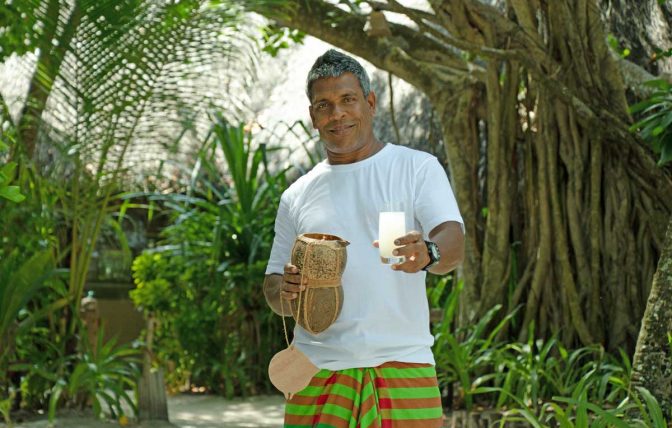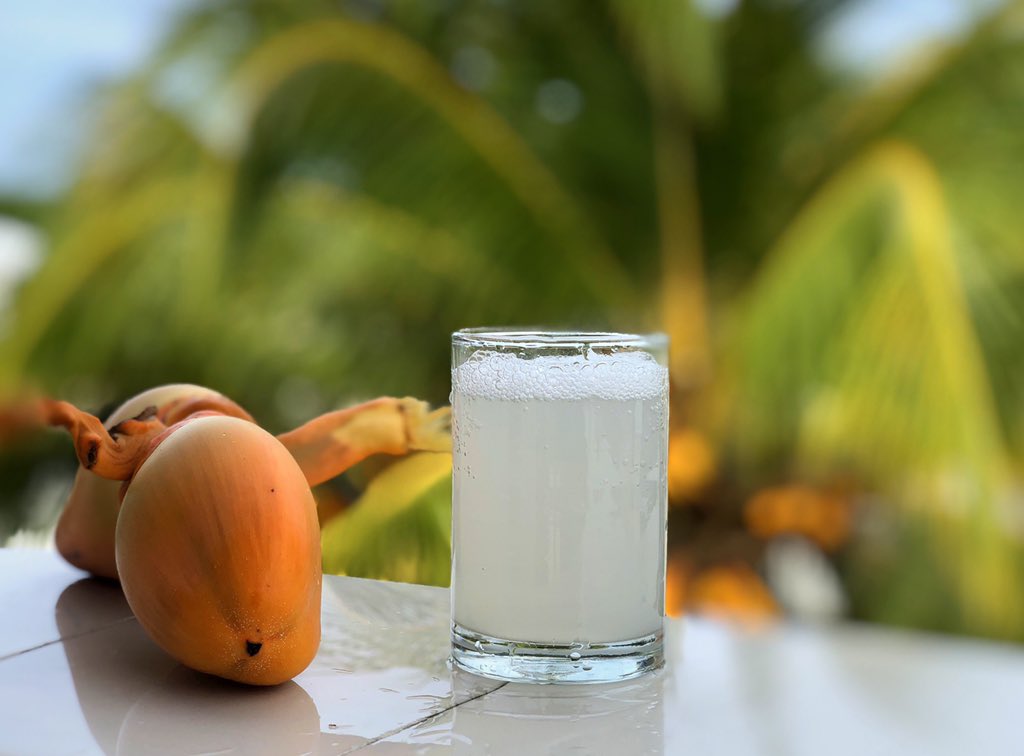


‘Ruku Raa’ or coconut palm toddy is one of the most popular local brews that you can have while in the Maldives. ‘Raa verikan’ (toddy tapping) is one of the earliest known professions in the country and the ‘raa veriyaa’ (toddy tappers) were among the most respected people in a Maldivian community. Traditionally, even the tools and secrets of their trade were handed down from father to son.
While toddy can be made from several different varieties of palm trees, the local brew is made from the sap of coconut palm trees. To make the toddy, the tapper first climbs the tree and uses a special collecting pot made from coconut shells called a ‘gudi’ to collect the sap from a cut on the inflorescence of the coconut tree flower. The liquid collected from this process is white and tends to be very sweet, but since it begins fermenting immediately upon contact with air – due to natural yeasts in the air – the sap eventually turns into the mildly alcoholic brew known as toddy. Since the collection process takes a long time, tappers will usually leave the ‘gudi’ overnight and collect it the next morning in another special container called a ‘raa badhi’, which is made from two or three empty coconut shells joined together to make a larger container.
Expert toddy tappers know exactly how long to keep the fermenting processing going on in order to achieve various levels of sweetness in the brew. Toddy collected in the evening is generally regarded to be the sweetest.

The word ‘ruku raa’ literally means ‘coconut tree wine’, and since the brew is mildly intoxicating the name is very apt. Although the number of toddy tappers still in business has dwindled considerably in the Maldives in recent years, there are still many residents in many islands of the Maldives who still make a good living by selling toddy. However, there is always the danger that the occupation will die out eventually and the Government has recently taken a hand in trying to revive this dying culture by introducing toddy tapping courses in the islands. Even if it was only just a good drink, toddy would have served a very important service in traditional Maldivian culture. However, Maldivians have many other uses for toddy.
Heat it up and you end up with ‘dhiyaa hakuru’ a golden honey-like syrupy liquid that has more than a striking resemblance to maple syrup. Consequently, ‘dhiyaa hakuru’ itself is very versatile and can be mixed with several other staple foods in the Maldives such as rice or roshi. It is also the main ingredient in sweet cakes, and some types of desserts and snacks. If you cook ‘dhiyaa hakuru’ even further under a low-heat and throw in a pinch of sugar and a particular form coral, and then leave in on heat for an extended period of time it will eventually turn into a creamy-white paste which locals call “karu hakuru.” This thick paste is often used as a dipping sauce for breadfruit chips and other snacks. One of the best things about these toddy products is that they wouldn’t get spoiled even if they were kept in storage for months even without refrigeration or added preservatives.
Another use that toddy is put to in the Maldives is in the making of pickles. When toddy is allowed to ferment for a long time it will eventually turn into vinegar with a strong acidic flavor. This vinegar is used to give added flavor to certain food products and also as a preservative in the making of many types of local pickles.
While tourists to the Maldives will be very lucky indeed if they are able to find someone selling locally brewed ‘ruku raa’ while in Malé or in some islands, many of the other types of food products made from toddy are readily available at the local market area in Malé.
Featured Image: Coco Palm Dhuni Kolhu